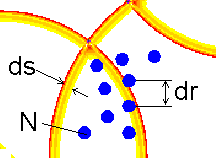On the way to find pictures of thought?
Pool of Neurons versus Interference Nets
The wavelength of nerve pulses is approximately between micrometres (non-myelinated) and millimetres (myelinated) [1]. The difference between different modelling techniques can be seen approximately in this dimension: If we suggest, that neural excitement is higher, as more closed different partial impulses reach the location of sensation in the neuron, it appears clear, that incoming impulses have to appear within the interval of their wavelength. Thus, the abstraction 'pool of neuron' (Amari) is valid within a single wavelength interval. If we suggest, most neurons have some axonal or dendritic wiring in the millimetre range, this means, pool of neuron models are not useful to model nerve nets anyway.
Instead we have to interprete nerve nets with delaying wires and space-time-functions. Central we have to ask for superimposition criteria in space-time dimensions.

Fig.: A wave moves over a fictive neural grid of neurons N. If the wave length ds comes into the range of the grid size dr it is not longer possible, to use the "pool of neuron"-abstraction. Finding out wave length in the micrometer or millimeter range [1] or remarking neurons to have trees in the centimetre range, we have to consider the neural space in physical dimensions of wave interference.
May be this is the main idea of all models and simulations in this homepage.
Reference
[1] Heinz, G.: Relativitaet elektrischer Impulsausbreitung - Schluessel zur Informatik biologischer Systeme. 39. Int. Wiss. Kolloqium an der TU Ilmenau, 27.-30.9.1994, S.238-245 (auch als HTML-File)
© Copyright: G. Heinz
Visitors since Dec. 2021:
File created 10:02 06.12.1996
gh